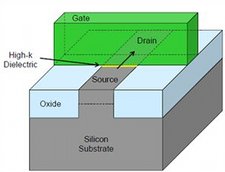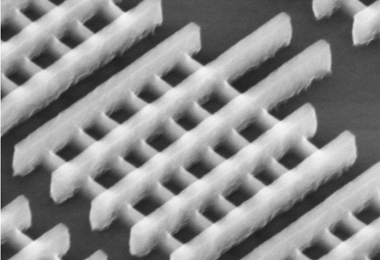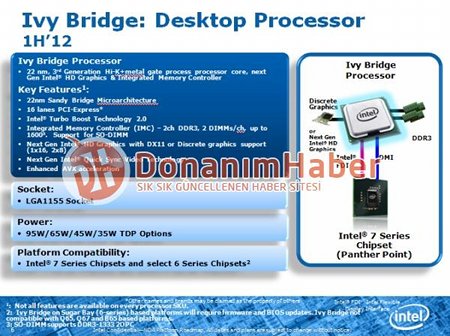Intel unveils 3-D transistor breakthrough
May 4, 2011 — by LinuxDevices Staff — from the LinuxDevices Archive — 1 viewsIntel announced what it's describing as the world's first 3-D transistors, set to be included in its 2012 “Ivy Bridge” Core processors. The “Tri-Gate” design will ensure that “Moore's Law,” dictating that transistor density doubles every two years, will keep moving along.
As we reported on May 2, Intel had been expected to use its May 4 press conference to promote its progress in making computer chips smaller (and, hence, cheaper and more economical on power). Most of the company's offerings still have circuitry that's 45 nanometers apart, but 32nm devices are also in production, and 22nm and 14nm versions have been promised for next year.
Indeed, the chip giant did talk up its 2012 "Ivy Bridge" Core processors (see later in this story), already known to be using a 22nm process. But it also pulled a rabbit out of a hat in the form of its new 3-D "Tri-Gate" technology, billed as "a significant breakthrough in the evolution of the transistor."


2D transistors (left) and 3D Tri-Gate transistors (right)
Source: Intel
(Click either to enlarge)
As Intel notes, transistor manufacturing to date has been essentially flat (planar) on a silicon wafer (above left). The Tri-Gate technology replaces the flat conducting channels with 3D "fins" (above right) that rise up vertically from the silicon substrate.
Control of current is said to be accomplished by implementing a gate on each of the three sides of the fin — two on each side and one across the top — rather than just one on top, as is the case with the 2-D planar transistor. According to Intel, this additional control enables as much transistor current flowing as possible when the transistor is in the "on" state (for performance), and as close to zero as possible when it is in the "off" state (to minimize power). It also enables the transistor to switch very quickly between the two states (again, for performance).

Greatly magnified view of a Tri-Gate transistor
Source: Intel
Intel says its 22nm 3-D Tri-Gate transistors will offer the same performance as 2D planar transistors on 32nm chips while consuming "less than half" the power. This "incredible gain" will make them ideal for use in small handheld devices, the company adds.
Moore's Law — named for Intel co-founder Gordon Moore — is a forecast for the pace of silicon technology development stating that, roughly every two years, transistor density will double, decreasing costs while increasing performance. The law had been expected to start bumping up against physical limits as transistors shrink, since atoms themselves are approximately 0.5nm wide.
But now, says Intel, the Tri-Gate technology will let chip designers manage density just as urban planners do by building skyscrapers. Future iterations will let designers continue to grow the height of the fins, getting further gains in performance and energy efficiency, the company adds.
Moore was quoted as saying, "For years we have seen limits to how small transistors can get. This change in the basic structure is a truly revolutionary approach, and one that should allow Moore's Law, and the historic pace of innovation, to continue."
Intel Senior Fellow Mark Bohr stated, "The performance gains and power savings of Intel's unique 3-D Tri-Gate transistors are like nothing we've seen before. This milestone is going further than simply keeping up with Moore's Law. The low-voltage and low-power benefits far exceed what we typically see from one process generation to the next."
According to Intel, the 22nm Tri-Gate process will make its debut in the "Ivy Bridge" Core CPUs (below), slated for high-volume production by the end of this year (and, we expect, a formal announcement at January 2012's Consumer Electronics Show). The company added that the technology will also be used in future Atom processors and SoCs, including devices that will require less than 1mW of idle power.
Intel's 22nm, 3-D Tri-Gate technology
(click to play)
The 2012 Ivy Bridge Core processors
Intel did not reveal much additional detail about its 2012 "Ivy Bridge" Core processors. Convincing-looking slides leaked last month by the Turkish website DonanimHaber had already suggested the devices would begin appearing during the first half of next year, though they gave no hint as to the apparently dramatic gains in power efficiency.

Intel's Ivy Bridge Core
Source: DonanimHaber
(Click to enlarge)
While featuring the same basic microarchitecture as before, the "Ivy Bridge" CPUs will apparently gain improved graphics — with DirectX 11 compatibility and support for three independent displays. They'll also feature a 2.0 version of Intel's TurboBoost technology, the slides appeared to suggest.

Intel's Panther Point chipset
Source: DonanimHaber
(Click to enlarge)
The slides further indicated that Ivy Bridge CPUs will use the same LGA 1155 sockets as their Sandy Bridge forebears. Meanwhile, it's said, a new 7 Series chipset code-named "Panther Point" (above) will be compatible with both the 2011- and 2012-model Cores, and will provide systems based on them with Intel's first support for USB 3.0, among other improvements.
Further information
More information on Intel's 3-D transistor technology may be found on the company's Tri-Gate web page.
Jonathan Angel can be followed at www.twitter.com/gadgetsense.
This article was originally published on LinuxDevices.com and has been donated to the open source community by QuinStreet Inc. Please visit LinuxToday.com for up-to-date news and articles about Linux and open source.